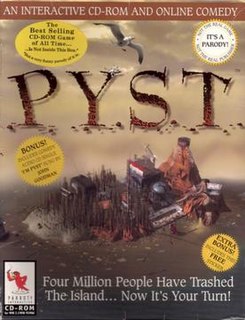
Pyst is an adventure computer game released in October 1996. It was created as a parody of the highly successful adventure game Myst. Pyst was written by Peter Bergman, a co-founder of the Firesign Theatre, and was published by Parroty Interactive, with Bergman, Stallone, Inc. as co-publisher. Mindscape began distributing the game on August 20, 1997. The parody features full motion video of actor John Goodman as "King Mattruss", the ruler of "Pyst Island". Versions of the game were produced for both the Windows PC and Apple Macintosh operating systems.

Hopkins FBI is a 1998 point-and-click adventure game from MP Entertainment, most famous for very large amounts of gore. An unreleased sequel was in the works for a time being called Hopkins FBI 2: Don't cry Baby.

Necronomicon: The Dawning of Darkness, also known as Necronomicon: The Gateway to Beyond, is a 2000 video game developed by Wanadoo Edition and released for Windows and the PlayStation video game console.

The Secret of the Nautilus is a 2002 adventure video game, inspired by Jules Verne's science fiction novel Twenty Thousand Leagues Under the Sea. It was developed by Cryo Interactive and released for Microsoft Windows based PCs.

Road to India is an adventure video game released in 2001, that was developed and published by Microïds.

Martin Mystère: Operation Dorian Gray, is the only video game adaptation of the Italian sci-fi detective comic-book franchise called Martin Mystère, starring a detective and his assistant, Java. It is a point-and-click adventure game, published in 2005 by The Adventure Company in North America and GMX Media in Europe. A Macintosh version was planned, but was cancelled in the evaluation stage. Versions for PlayStation 2 and Xbox were also planned, but were also cancelled.

Clue Chronicles: Fatal Illusion is a Windows point-and-click adventure game based on the Cluedo franchise, known as Clue in North America. It is a reinterpretation and adaption of the Clue board game as an adventure game including many of the original characters. The game was distributed with a variety of covers, each featuring a different murder weapon.

Riddle of the Sphinx: An Egyptian Adventure is a 2000 graphic adventure game developed by Old World Studios and published by DreamCatcher Interactive. It received a sequel, entitled The Omega Stone: Riddle of the Sphinx II, in 2003.

Putt-Putt Travels Through Time is a 1997 video game and the fourth of seven adventure games in the Putt-Putt series of games developed and published by Humongous Entertainment. In 2014 Night Dive Studios re-released the iOS, Linux and Steam versions. This is the last game to feature Jason Ellefson as the voice of Putt-Putt.
The Arthur video games franchise was a series of learning and interactive story video games based on the American-Canadian children's TV show Arthur. The games were released in the 1990s and 2000s for PlayStation and Windows and Mac OS computers.
Blue's Treasure Hunt is a 1999 educational video game developed and published by Humongous Entertainment, based on the Blue's Clues television series.

Club Penguin Island was a massively-multiplayer online role-playing game (MMORPG) and the successor to Club Penguin. The game was released worldwide on March 29, 2017 and was created by Disney Canada Inc. in order to keep the Club Penguin franchise alive as closing its predecessor, Club Penguin, was necessary. The game's public beta testing period took place in Australia and New Zealand from December 15, 2016 to its worldwide release, and in Canada from January 13, 2017 to its worldwide release. The game was discontinued on December 20, 2018.

Byzantine: The Betrayal is a video game, released September 30, 1997 for Microsoft Windows.

Pilgrim: Faith as a Weapon is a 1997 adventure video game, written by Paulo Coelho, who wrote The Pilgrimage, the novel on which the game is based. Pilgrim has been described as a "commercial cultural heritage game" and "graphic interactive fiction". It is the premiere title of Arxel Tribe and the first in The Paulo Coelho trilogy, which also includes The Legend of the Prophet and the Assassin (1999) and The Secrets of Alamut (2001).

The Legend of the Prophet and the Assassin is an adventure game by Arxel Tribe. It is the sequel to Pilgrim: Faith as a Weapon. It is sometimes considered to be two games in the "Legend" series; The Prophet's Trail or The LegendPart 1 as Part 1 and The Secrets of Alamût or The Legend Part 2 as Part 2. It was released at one game under DreamCatcher Interactive in the United States. In some contexts, "The Legend of the Prophet and the Assassin" is used to refer to just the first game. The game is inspired by the work of Brazilian novelist Paulo Coelho.

Adventure at the Chateau d'Or is a 2001 adventure game, developed and published by Karma Labs.
Reah: Face the Unknown is a 1998 first-person puzzle-oriented adventure game with a non-linear plot, described as a Myst-clone. It was developed by Project Two Interactive / Black Friar and published by Detalion and LK Avalon. It was distributed by Erbe in Spain in October 10, 1998. It was published by Project 2 Interactive in the Netherlands, and distributed in the U.S. and Canada by GT Interactive.
Smart Games Challenge is a video game series developed by KnowWare and Smart Games. Three games were released between 1996-8.
Auryn Quest is a run-and-jump adventure game based on Michael Ende's novel The Neverending Story and his film adaptation of the same name. It was originally developed by Discreet Monsters, and was finished by Attraction after the former company went bankrupt from "bad luck and mishaps".

Santa Fe Mysteries: The Elk Moon Murder is a video game, the first in the Santa Fe Mysteries series, followed by Santa Fe Mysteries: Sacred Ground.














